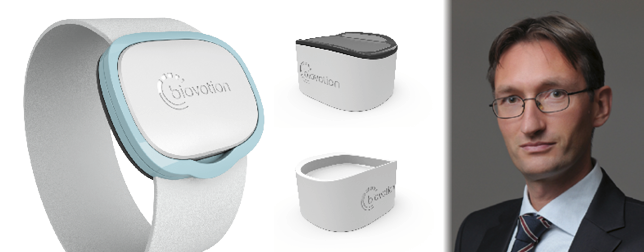Biovotion AG is a Swiss based medical device company, providing solutions for continuous, non-invasive physiological monitoring. WT | Wearable Technologies cooperates with Biovotion since 2013 and the company aims to show their VSM platform at the WT | Wearable Technologies Show 2015 MEDICA in November. Learn more about the product in an interview with CEO Andreas Caduff.
1. Biovotion provides solutions for continuous, non-invasive physiological monitoring. The Vital Sign Monitoring (VSM) platform has won several prices. Can you shortly explain your solution?
The Biovotion VSM platform belongs to the classes of so called Multisensor devices. Which means it combines different sensors into one single housing. This offers the advantage that different physiological parameters can be monitored with one single device. The device is attached to the upper arm with an expandable band. The VSM does neither require tape, cables, calibrations nor buttons to be used and operated. Biovotion follows a very minimalistic user interface and aims to arrive at a device that is ultimately easy to use. The VSM provides motion tolerant vital sign monitoring under everyday conditions and therefore allows medical grade data to be collected outside the hospital. The platform can be expanded step by step, offering additional valuable parameters over time. The VSM can be integrated into eco systems to have the collected data be made available for further more sophisticated data processing, sharing with care takers or other service providers. With accurate physiological readings it is predestined to be combined with what we would call codified expert knowledge (i.e. prognostic health monitoring), which are routines that allow such sophisticated data evaluation leading towards actionable information as well as at “scalability”, which is a key element. The overall offering of the VSM platform is probably seen as very attractive by the jurors of the various competitions and indeed has therefore allowed Biovotion to be awarded with numerous prestigious prices. This is obviously very motivating for our team to continue its dedicated work towards truly value adding wearable medical grade monitoring solutions to people in need.
2. You announced your cooperation with exceet/ECR to manufacture the body monitor – the certification process starts already this year. When are you planning to launch your product?
Indeed with the exceet group we not only have found a very motivated partner but also a group that offers many of the required elements needed to make such complex VSM1 offering become a very smooth user experience. This goes from encryption solution for data security, to wireless technology or pairing and identification to medical grade manufacturing also of larger quantities.
Biovotion aims to show the product at the WT | Wearable Technologies Show 2015 MEDICA in November this year. It will be the VSM1 so the first generation of the VSM platform that features the main vital signs. Regulatory clearance is expected thereafter, first in the EU and then followed by the FDA and other local authorities. The VSM1 will be a medical device class 2. We are therefore looking to bring VSM1 as a medical device into the hands of our business partners by Q1/2016.
3. Biovotion joined the WT | Wearable Technologies Show at MEDICA in 2013 for the first time. Do you see a change in the acceptance of wearables in the medical field? And do you see a difference in companies creating wearables for the health market?
“Wearables”, maybe a sometimes ambiguous term, depending on what is really meant, have obviously seen a major surge in public and institutional awareness in the very recent years. We have seen a development from simple and very nicely designed motion trackers that have motivated people to become more active, towards higher integrated and more sophisticated offerings that are aiming at either specific medical conditions and/or at a service that allows people do something they could do before, safe time or money. Preferably it will be a combination of these elements.
A process we have observed as well and we very much appreciate is the convergence of appealing industrial design with functionalities from the medical device arena and the eco system architectures of the IoT/ICT arena. We see that this combination including elements from the microtechnology, codified expert knowledge or material science is helping companies like us and many others to come up with offerings that can really become game changing in the ongoing process of the consumerisation and digitalisation of healthcare. In essence one can observe two mechanisms, either we are looking at medical device companies that want to become “wearable” or at a consumer (tech) company that want to become “health”. It remains to be seen which group can really arrive at more sustainable offerings for the health market.
4. What factors are – in your eyes – crucial for creating a “perfect” wearable device?
Accuracy, true easiness of use, data availability and its combination with sophisticated codified expert knowledge to offer added value and actionable information that helps the user over a longer period of time. In order to reach the first two one needs to have a device that can be comfortably worn over a longer period of time, then only with a well defined attachment concept accuracy can be achieved. Also such a wearable needs to come embedded into audience specific eco systems to fully unfold its value.
5. Do you have a favorite wearable (besides your own)?
We like those wearables that can offer feature(s) that allow a function or service that leads to a sustainable use, also we like those that succeed to surprise in terms of industrial design and its attachment concept again supporting a longer term use. Generally, we enjoy to discover creative wearables that are truly thought out as an overall system.
If you want to speak to Andreas Caduff and the Biovotion team in person, do not hesitate to drop by at our booth at MEDICA 2015 in hall 15 on November 16-19.













